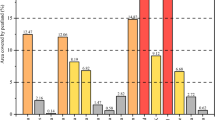Abstract
Engineers and scientists are in search of new construction materials to advance exploration in space and to reduce our CO2 emissions on Earth. Biopolymer-bound Soil Composite (BSC), a promising novel construction material, is being investigated for extrusion-based 3D printing applications that could both assist in lunar habitat construction and reduce earth-based CO2 emissions. For extrusion-based 3D printing applications, knowledge of BSC structuration is required. In this study, we evaluated the formation of a crust on the outer surface of BSC test specimens at various desiccation levels and the effect of the crust on the strength of the specimens. We measured the crust depth, determined the crust moisture content, and performed uniaxial compressive strength testing for selected specimens. We found that the depth of the BSC crust develops linearly with overall desiccation level and is the source of the specimen’s initial strength and stiffness. Additionally, we found that the crust begins to form when the biopolymer solution concentration at the specimen surface reaches a critical value and then moves inward with moisture loss. A methodology for modeling BSC structuration is developed based on knowledge of the BSC mixture design, the level of BSC desiccation, and the crust-forming biopolymer solution concentration.













Similar content being viewed by others
Notes
The water concentration was calculated by dividing the mass of water by the total mass (water, soil, and biopolymer). This value is not the same as the moisture content, defined in BSC research as the mass ratio of water to soil [4]. The initial BSC mixture had a water concentration of 11.5% and moisture content of 14.3%.
The use of a quadratic growth function resulted in better model agreement with experimental data compared to a linear or cubic growth function, and the nonlinear function is consistent with surface drying profiles found in the literature [20].
The [%w/w]BP*(r = R) = 100% assumption can only be valid in an environment with no water vapor (0% R.H.); however, this approximation is suitable for most drying environments.
References
Roussel N (2018) Rheological requirements for printable concretes. Cem Concr Res 112:76–85. https://doi.org/10.1016/j.cemconres.2018.04.005
Amanda Hasse J, Prevedello Rubin A, Carvalho Quintanilha L, Longuini Repette W, Hasse JA, Rubin AP, Quintanilha LC, Repette WL (2020) Increasing structuration rate of 3D printable concretes: the effect of viscosity enhancing admixtures. Rev IBRACON Estruturase Mater 13:2020.https://doi.org/10.1590/S1983-41952020000400012
Rahul AV, Santhanam M, Meena H, Ghani Z (2019) 3D printable concrete: mixture design and test methods. Cem Concr Compos 97:13–23. https://doi.org/10.1016/j.cemconcomp.2018.12.014
Roedel H, Rosa I, Lepech M, Loftus D (2015) Sustainability assessment of protein-soil composite materials for limited resource environments. J Renew Mater 3:183–194. https://doi.org/10.7569/JRM.2015.634107
Rosa I, Roedel H, Allende MI, Lepech MD, Loftus DJ, Henning R, Allende MI, Lepech MD, Loftus DJ (2020) On designing biopolymer-bound soil Composites (BSC) for peak compressive strength. J Renew Mater 8:845–861. https://doi.org/10.32604/JRM.2020.09844
Allende MI, Lepech MD, Loftus DJ (2017) A performance-based impact engineering framework: a probabilistic approach to quantify micrometeorite damage to lunar surface structures. Proc Int Astronaut Congr IAC 1:164–172
Panda B, Lim JH, Tan MJ (2019) Mechanical properties and deformation behaviour of early age concrete in the context of digital construction. Compos Part B Eng 165:563–571. https://doi.org/10.1016/j.compositesb.2019.02.040
Perrot A, Rangeard D, Levigneur A (2016) Linking rheological and geotechnical properties of kaolinite materials for earthen construction. Mater Struct Constr 49:4647–4655. https://doi.org/10.1617/s11527-016-0813-9
Perrot A, Rangeard D, Courteille E (2018) 3D printing of earth-based materials: processing aspects. Constr Build Mater 172:670–676. https://doi.org/10.1016/j.conbuildmat.2018.04.017
Biggerstaff A, Fuller G, Lepech M, Loftus D (2021) Determining the yield stress of a Biopolymer-bound soil composite for extrusion-based 3D printing applications. Constr Build Mater 305:124730. https://doi.org/10.1016/J.CONBUILDMAT.2021.124730
ASTM E104 (2020) Standard practice for maintaining constant relative humidity by means of aqueous solutions 1, https://doi.org/10.1520/E0104-20A.
Coussot P (2005) Rheometry of Pastes, suspensions, and granular materials, John Wiley & Sons, Inc., Hoboken, NJ, USA, doi.org/https://doi.org/10.1002/0471720577
ASTM C39, C39M (2021) Standard test method for compressive strength of cylindrical concrete specimens 1. ASTM Stand B 1:1–5. https://doi.org/10.1520/C0039
A. Biggerstaff M, Lepech D, Loftus A, (2021) Shape Stability Model for 3D Printable Biopolymer-Bound SoilComposite, Constr. Build. Mater. Pre-Print.
Jaenicke R (1990) Protein structure and function at low temperatures, Philos. Trans. R. Soc. London. B. Biol. Sci. 326:535–551. https://doi.org/10.1098/RSTB.1990.0030
H. Roedel, (2017) On the Compressive Strength and Sustainability of Protein Bound Concretes, Stanford University.
Yiotis AG, Tsimpanogiannis IN, Stubos AK, Yortsos YC (2007) Coupling between external and internal mass transfer during drying of a porous medium. Water Resour Res 43:6403. https://doi.org/10.1029/2006WR005558
Brownsey GJ, Noel TR, Parker R, Ring SG (2003) The glass transition behavior of the globular protein bovine serum albumin. Biophys J 85:3943–3950. https://doi.org/10.1016/S0006-3495(03)74808-5
Wilson GW, Fredlund DG, Barbour SL (1994) Coupled soil-atmosphere modelling for soil evaporation. Can Geotech J 31:151–161. https://doi.org/10.1139/t94-021
Ginzburg AS, Dubrovskii VP (1966) Moisture distribution in granular material during drying in a fluidized bed. J Eng Phys 11(3):175–178. https://doi.org/10.1007/BF00829571
Acknowledgements
The authors would like to thank the John A. Blume Earthquake Engineering Center at Stanford University for laboratory equipment funding and other resources. The authors would also like to acknowledge the U.S. Army for partially funding this research through the Advanced Civil Schooling (ACS) program. Additionally, the authors would like to thank SSERVI-NASA for supplying the BP-1 lunar regolith simulant. Any opinions, findings, and conclusions or recommendations expressed in this material are those of the authors and do not necessarily reflect the views of the United States Army or NASA.
Author information
Authors and Affiliations
Corresponding author
Ethics declarations
Conflict of interests
The authors declare that they have no known competing financial interests or personal relationships that could have appeared to influence the work reported in this paper.
Additional information
Publisher's Note
Springer Nature remains neutral with regard to jurisdictional claims in published maps and institutional affiliations.
Rights and permissions
About this article
Cite this article
Biggerstaff, A., Lepech, M. & Loftus, D. Determining the structuration of biopolymer-bound soil composite. Mater Struct 55, 190 (2022). https://doi.org/10.1617/s11527-022-02004-9
Received:
Accepted:
Published:
DOI: https://doi.org/10.1617/s11527-022-02004-9




